Trekking through damp woodlands in the Scottish Highlands, I pause and look down at my feet. On a thread-like deer trail on a steep hillside, animal footprints have been pressed into a hollow of mud. I reach into my backpack and take out a battered field guide. I identify the imprints as those of a pine marten; an elusive UK carnivore that I’m told is partial to eating small rodents, eggs, insects… and peanut butter if there are generous humans around. With luck, I may see the trackmaker itself. I tread quietly onward through the forest.
For palaeontologists, identifying the makers of a fossil footprint is not so simple. There are no handy laminated field guides matching dinosaur species to their tracks, or ancient insects to their burrows. The only way to link a fossil animal directly to its imprints is to find it, literally, dead in its tracks.

The term fossil footprint may seem like a misnomer. The word fossil is more commonly applied to the mineralised bones or tissues of long extinct animals: body fossils. A more accurate term for preserved tracks is ichnofossils, from the Greek for footprint. Ichnofossils include not only the tread of passers-by, but many other traces of biological activity: burrows, root cavities, and even coprolites (that’s fossil poo to the uninitiated).
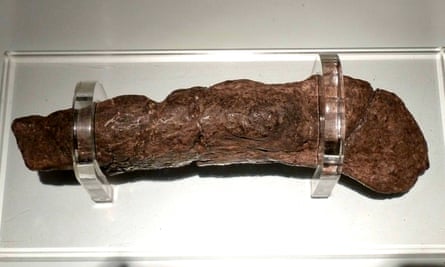
But how do these hollows and impressions turn into ichnofossils? What accident of geology converts the wanderings of a sauropod dinosaur across a mudflat, into a rock cast that survives millions of years of deposition, compression and erosion?
“When I go for a walk along the foreshore of a beach, I leave footprints in the sand,” Paige dePolo, a Masters Student at the University of Edinburgh working on Scottish ichnofossils explains. “But as I walk along, the tide washes them away behind me: I’ve got no hope of them being preserved for posterity.” dePolo reflexively pushed her glasses up her nose before continuing: “what we need to form a trace fossil is a low-energy environment, and a substrate that is soft enough for my foot to sink into, but not so soft that the print just liquefies and fills in.”
It was in such an environment that the footprints dePolo studies, those found in Northern Skye, Scotland, were formed. She focuses on three sites, all of them Middle Jurassic, coastal environments on a seaway cutting between what is now mainland Scotland and the Outer Hebrides. “There were rivers flowing into the ocean and depositing sediment, protected lagoons, and exposures of soft mud,” dePolo describes - the environment was “a dynamic coastline.”
The tracks consist of two types of fossil footprint: impressions and casts. The impressions have been preserved as hollows, and often form miniature rockpools. The casts are infilled footprints, and the infill has survived while the surrounding rock has eroded away. Changes in the preservational environment in the thousands or millions of years between the creation of each set of prints results in these different forms of ichnofossil.

Such trackways have been found on Skye for many decades. One of the most prolific fossil finders is Dugald Ross, owner of the Staffin Dinosaur Museum. I met up with him last year during fieldwork on Skye. A soft-spoken Gael, Ross has been finding fossils on Skye since he was in his teens. Later, he created the museum – a small stone croft by the roadside that was once the local Gaelic school - to house them, alongside other items from Skye’s cultural and natural heritage. Ross’s considerable efforts have recently been acknowledged by the Palaeontological Association, who presented him the Mary Anning Award; for those who have made outstanding contributions to palaeontology, but are not formally employed in research.
During field work on Skye last year, Ross and I split off from the rest of my University of Edinburgh co-workers. He led me along the rocky foreshore, clambering nimbly in his industrial waterproofs. “There, see?” Ross pointed to a reddish slab the size of a dinner table. It lay tilted among the precarious debris of a cliff-fall, and I’d have walked past it without glancing twice. He used a salt-rough finger to draw around their outlines, and suddenly I could see them: like a magic eye image, the three-toed prints came into focus. They criss-crossed the sandstone like the scatty wanderings of a giant turkey. It was a strangely moving experience to place my hand on the exact spot a predatory dinosaur stepped over 160 million years earlier.
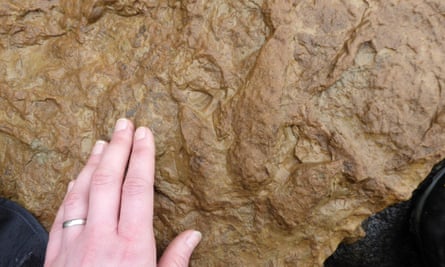
Dinosaur imprints can be broadly identified into groups: the three-toed turkey-tracks belong to theropods, those famously carnivorous, two-legged dinosaurs. Sauropods leave big round prints like wonky dinner plates, fringed with crazy little toes at the front. Ornithiscian dinosaur feet, such as stegosaurs, are wide at the back, with comparatively larger, neater toes than the sauropods – and they are a lot smaller than their long-neck compatriots. There are places where the fossil record is comprehensive enough to allow palaeontologists to match such footprints to local dinosaurs with reasonably high confidence. But this is the exception, rather than the rule.
As fossil footprints cannot tell us definitively which animals made them, they are of limited use for answering questions about diversity, population numbers, or distributions of extinct creatures. For every animal that lived on earth there is one chance of leaving a body fossil, but in a lifetime they may have left a multitude of footprints. There is information trackways can provide that body fossils rarely can: evidence of behaviour.
“I’m going to be looking for patterns in the footprints to try to understand what the dinosaurs were doing in ancient environments” dePolo tells me. She is currently mapping the footprints of Skye; figuring out how they relate to one another and looking for evidence of dinosaur behaviours in how they intersect. “I’ll be using a drone to create a photogrammetric model of the site. This model will supplement the map by showing the tracks in 3D space, and help to understand how the tracks relate to one another.”
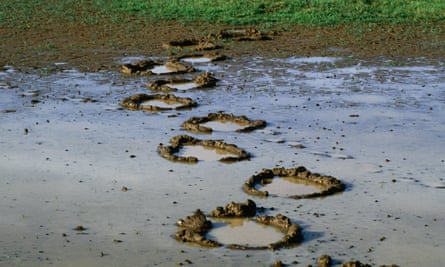
Dinosaurs are far from the only ones who left casts of their feet behind in the rock record. Every group of animal life has left its mark: from Cambrian millipedes and Devonian tetrapods, to early humans. Because the exact culprit so often can’t be matched to their print, ichnologists instead name their fossil footprints and other trace fossils independently of the species that made them. They use the same naming system as for living things, classifying them by their shape and the behaviours they betray. One beautiful recent example, is Brasilichnium saltatorium.
In the sandstone quarries of the sweaty Paraná Basin in Southern Brazil, hundreds of rocks containing ichnofossils have been saved from commercial use. They were earmarked as paving slabs, yet these stones once formed the walkways of myriad small vertebrate animals and their invertebrate prey, all leaving their mark for posterity.
The rocks are from the Botucatu Formation: an expansive sandy desert over 132 million years ago, in the Early Cretaceous. This wind-sculpted landscape spilled its dunes across the conjoined continents of South America and Africa - the Southern Atlantic Ocean was only just forming at this time to split them apart. Although much of this desert was arid, some areas had a wetter climate, with rainfall episodes creating fleeting lagoons and swelling groundwater reservoirs. It was in these slightly damper regions that trace fossils like Brasilichnium were formed.
Brasilichnium elusivum was named in 1981 for sets of tiny mammal-like tracks in the Botacatu Formation sandstone. These footsteps are barely more than a centimetre or two in length and can, amazingly, sometimes include impressions of little claws and even a tail, dragging behind. A recent paper by a team from Brazil described a new ichnospecies of these tracks: Brasilichnium saltatorium. These prints differ from the originals because unlike the walking gait observed previously, they clearly show these tiny Cretaceous desert-mammals were hopping. This is among the oldest evidence of a hopping gait in the mammal fossil record.
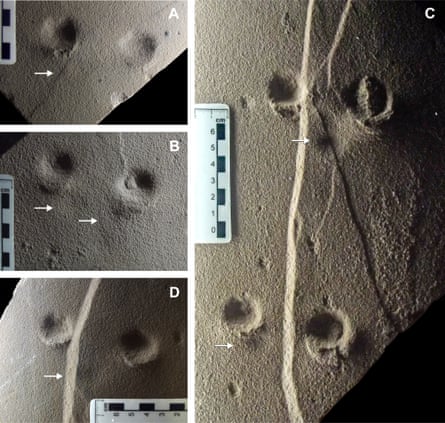
“The ichnological record greatly enriches what we know only through the record of body fossils,” explains Aline Ghilardi, co-author of the paper published in Palaeogeography, Palaeoclimatology, Palaeoecology. “It may not be a complete skeleton, but they are records of behaviours, which are rarely preserved in bones.”
The ichnospecies name, saltatorium, comes from saltatorial: a zoological term used for animals that move using jumps or leaps. Such hopping is a relatively common form of locomotion in several modern animal groups, most famously among kangaroos. Whereas kangaroos are strict hoppers, moving their hind limbs synchronously, many modern small mammals leap only when picking up speed, their forefeet landing first and their hindfeet often hitting the ground in front of the forefeet, before pushing off and repeating this cycle of motion. When moving slowly however, these small mammals walk with alternating footfalls. In B. saltatorium, the leaps were mostly around ten centimetres in length, but the longest jump found is 41.2cm – quite a distance for an animal probably no larger than a squirrel.
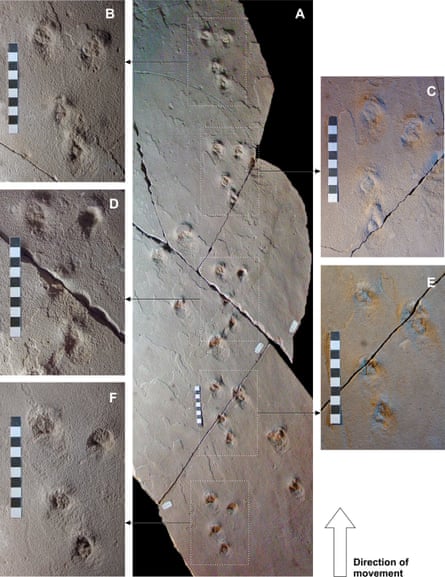
The Brazilian research team compared their fossil tracks to those of the modern-day gerbil, Meriones unguiculatus. This little rodent, best-known as a common childhood pet, comes from the Mongolian semi-desert and steppe. They also hop when moving quickly; taking long leaps to quickly cover distance, perhaps to catch insects, or escape predators such as birds of prey.
By comparing the Cretaceous trackways of the Botacatu desert with those made by modern gerbils, the researchers were able to identify when their Brasilichnium saltatorium trackmakers were running up or down steep dunes, or along flat surfaces. They also observed B. elusivum’s walking footsteps transitioning into B. saltatorium, as the animals picked up speed to dart across their arid landscape. This suggests the two types of tracks were made by the same animal, and follow the same pattern of walking at slow speed, and leaping to go faster.
But what kind of animal made these tracks? The narrow, high-paced hops suggest a true mammal, as opposed to a close relative, but it is hard to say with certainty. The early members of several modern mammal groups existed in South America at this time, alongside extinct mammal groups, and probably some mammal-like cousins. With no body fossils preserved in the Botacatu Formation itself, no one knows what species occupied this desert ecosystem, or who the prints belonged to.
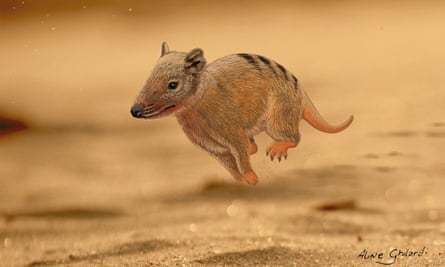
“There are still many questions waiting to be answered, regarding the Botucatu Formation,” says Ghilardi, “our research team is working hard to understand these clues of the past.”
The Botacatu ichnofossils and the footprints of Skye show us that even when there are few skeletons to be found, the animals of the past left us thousands of biological clues to their lives. They burrowed, they dragged, and yes, they even pooed their way into the fossil record. From the largest creatures to have ever tread across the earth, to the tiny scamperings of mammal ancestors, ichnofossils provide insights into behaviour: a glimpse of the movements of lifeforms we can barely imagine.
References
Brusatte SL, Challands TJ, Ross DA, Wilkinson M. 2016 Sauropod dinosaur trackways in a Middle Jurassic lagoon on the Isle of Skye, Scotland. Scottish Journal of Geology 52.1: 1-9.
Buck PV, Ghilardi AM, Peixoto BCPM, dos Reis Fernandes LB, and Fernandes MA. 2017 A new tetrapod ichnotaxon from Botucatu Formation, Lower Cretaceous (Neocomian), Brazil, with comments on fossil track preservation on inclined planes and local paleoecology. Palaeogeography, Palaeoclimatology, Palaeoecology, 466, pp.21-37.
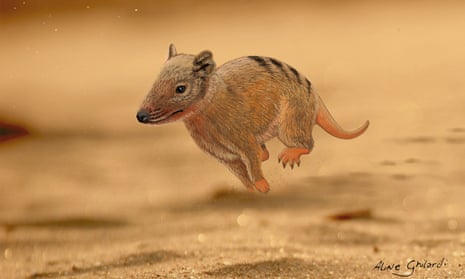

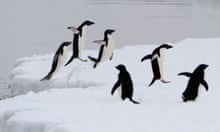






Comments (…)
Sign in or create your Guardian account to join the discussion